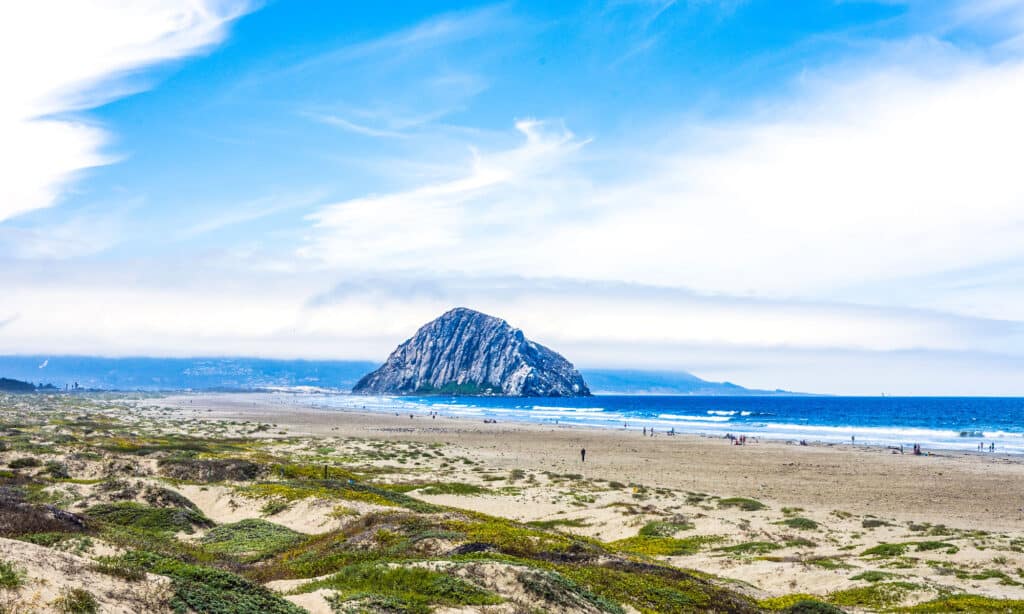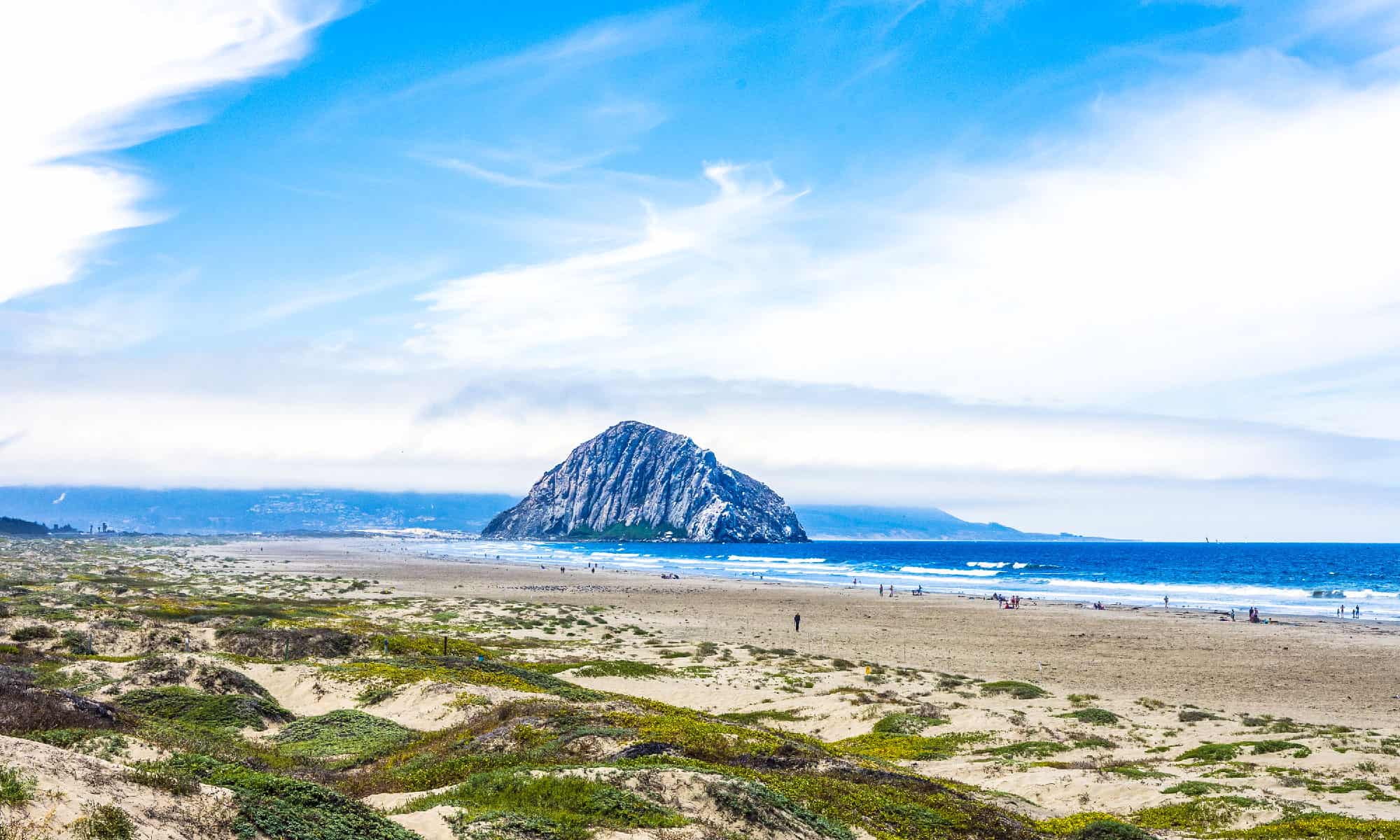Morro Rock towers over the vast, sandy beaches of Morro Bay, CA. Locals and visitors appreciate this unique rock, as it is an iconic feature of the small, seaside town. Morro Rock’s massive height is astounding. This article explores the location, history, and height of Morro Rock in Morro Bay.

Morro Rock
©randy andy/Shutterstock.com
Morro Rock Location
Morro Rock is located in Morro Bay, on the Central Coast of California. The Central Coast region spans from Monterey County to Ventura County. Morro Rock is in San Luis Obispo County, south of Monterey County and north of Santa Barbara County.
Morro Bay is a town and semi-enclosed estuary on the northern end of the larger Estero Bay. Estero Bay spans from Montaña de Oro State Park in the south to Point Estero, five miles northwest of the town of Cayucos, to the north. Chorro Creek and Los Osos Creek flow into Estero Bay in Morro Bay. The small bay is home to two marine protected areas, the Morro Bay State Marine Recreational Management Area (SMRMA) and Morro Bay State Marine Reserve (SMR). Additionally, Morro Bay is home to Morro Bay State Park, a lagoon featuring saltwater and brackish marshes.
According to the United States Census Bureau, Morro Bay has a population of 10,696.
Morro Rock History
An ancient dormant volcano formed the volcanic plug that is Morro Rock. It is one of the nine peaks of its kind in San Luis Obispo County. Collectively, these peaks are the “Nine Sisters” or the “Morros”. These nine ancient volcanoes erupted between 20 and 26 million years ago. The California Department of Conservation, using radiometric dating methods, determined that Morro Rock is 21 million years old.
Morro Rock is a sacred site for the Salinan and Chumash peoples, whose ancestral lands are on the Central Coast of California. The name for the rock in the Salinan language is Le’samo, and in the Chumash language, it is Lisamu. During the Millingstone Horizon of 6500-2000 B.C., the Chumash people had a settlement less than a mile away from the rock. Today, the Chumash and Salinan people disagree on whether or not people should climb the rock. The Salinan people won a legal dispute, and now climb the rock twice a year during solstice celebrations. However, it is illegal for the general public to climb it.
The rock was given the name Morro Rock during the Portolá expedition of 1769-1770, a Spanish exploration of California. A Franciscan missionary named Juan Crespí described the rock as a “round morro”. Morro means “snout” in Spanish.
Later, as Europeans settled on the Central Coast, Morro Rock was quarried. From 1889-1969, the Army Corps of Engineers removed 250,000 tons of rock from it. This rock created a breakwater in Morro Bay.
Morro Rock Height
According to the city of Morro Bay, Morro Rock is 576 feet tall. Although Morro Rock’s height is impressive and towers over the otherwise flat beach, it is actually the shortest of the Nine Sisters. The tallest of the Nine Sisters is Bishop’s Peak in San Luis Obispo, at 1,559 feet tall.
Wildlife Near Morro Rock
Morro Rock and the surrounding area contain incredibly important wildlife habitats. Among these habitats are the rock itself, the bay, marshes, and sand dunes. Many species of fish, marine mammals, and birds call this place home. Let’s explore some of the amazing animals living near Morro Rock.
Sea Otter (Enhydra lutris)

The sea otter is one of the few animals that use tools. They use rocks to open shellfish.
©Kirsten Wahlquist/Shutterstock.com
Sea otters live in the ocean water surrounding Morro Rock. They are a keystone species, meaning they are crucial to maintaining the ecosystem they are a part of. Sea otters eat sea urchins, which would damage kelp forests if their population grew out of control.
Peregrine Falcon (Falco peregrinus)

Peregrine falcons are the fastest animals in the world.
©Harry Collins Photography/Shutterstock.com
Morro Rock is an important nesting location for the peregrine falcon, which is rebounding from the brink of extinction since the 1970s. Peregrine falcons can dive at speeds over 200 miles per hour, making them the fastest animal.
Monarch Butterfly (Danaus plexippus)

Monarch butterflies lay eggs on milkweed plants, and the caterpillars eat only milkweed.
©Nancy Bauer/Shutterstock.com
Eucalyptus trees in Morro Bay State Park provide an important habitat for migrating monarch butterflies. The monarch butterflies travel from southern Canada to northern South America, spending winters on the California coast.
Visiting Morro Rock
Visiting Morro Rock is easy from the town of Morro Bay. Morro Bay is on California State Route 1, a highway that runs along the coast. Additionally, it is a short distance from U.S. Route 101, a major highway that runs from California to Washington.
The parking lot for Morro Beach, home of the rock, is at the end of Coleman Drive.
Where Is Morro Rock Located on a Map?
Thank you for reading! Have some feedback for us? Contact the AZ Animals editorial team.








